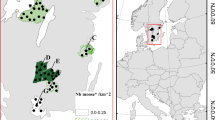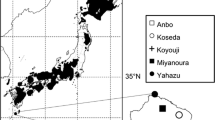Abstract
Langvatn and Hanley (1993) recently reported that patch use by red deer (Cervus elaphus) was more strongly correlated with short term rates of intake of digestible protein than dry matter. Such short term measures overlook effects of gut filling, which may constrain intake by ruminants over longer time scales (i.e., daily rates of gain). We reanalyzed Langvatn and Hanley's data using an energy intake model incorporating such a processing constraint, to determine whether their conclusions are robust. We found that the use of patches by red deer was just as strongly correlated with an estimate of the daily rate of intake of digestible energy as one of digestible protein during four out of seven trials, but slightly lower in three out of seven trials. In all cases, daily intake of digestible energy was a much better predictor of patch preference by red deer than was the intake of dry matter. Our reanalysis suggests that the daily intake of energy was highly correlated with that of protein in these trials, as may often be the case for herbivores feeding on graminoids. Hence the observed pattern of patch use by red deer could simultaneously enhance rates of both protein and energy intake.
Similar content being viewed by others
References
Ammann AP, Cowan RL, Mothershead CL, Baumgardt BR (1973) Dry matter and energy intake in relation to digestibility in white-tailed deer. J Wildl Manage 37:195–201
Armstrong DG (1964) Evaluation of artificially dried grass as a source of energy for sheep. II. The energy value of cocksfoot, timothy, and two strains of rye-grass at varying stages of maturity. J Agric Sci 62:399–413
Arnold GW (1985) Regulation of forage intake. In: Hudson RJ, White RG (eds) Bioenergetics of wild herbivores. CRC Press, Boca Raton, pp 81–101
Belovsky GE (1978) Diet optimization in a generalist herbivore: the moose. Theor Popul Biol 14:105–134
Casella G (1983) Leverage and regression through the origin. Am Stat 37:147–152
Doucet CM, Fryxell JM (1993) The effect of nutritional quality on forage preference by beavers. Oikos 67: 201–208
Fryxell JM (1991) Forage quality and aggregation by large herbivores. Am Nat 138:478–498
Fryxell JM, Vamosi SM, Walton RA, Doucet CM (1994) Retention time and the functional response of beavers. Oikos 71:207–214
Gates C, Hudson RJ (1978) Energy costs of locomotion in wapiti. Acta Theriol 22:365–370
Gross JE, Shipley LA, Hobbs NT, Spalinger DE, Wunder BA (1993) Functional response of herbivores in food-concentrated patches; tests of a mechanistic model. Ecology 74:778–791
Krebs JR, McCleery RH (1984) Optimization in behavioural ecology. In: Krebs JR, Davies NB (eds) Behavioural ecology. Blackwell, Oxford, pp 91–121
Langvatn R, Hanley TA (1993) Feeding-patch choice by red deer in relation to foraging efficiency: an experiment. Oecologia 95:164–170
Mellin TN, Poulton BR, Anderson MJ (1962) Nutritive value of timothy hay as affected by date of harvest. J Anim Sci 21:123–126
Mould ED, Robbins CT (1982) Digestive capabilities in elk compared to white tailed deer. J Wildl Manage 46:22–29
Myers RH (1986) Classical and modern regression with applications. Druxbury Press, Boston
Stephens DW (1985) How important are partial preferences? Anim Behav 33:667–669
Van Soest P (1982) Nutritional ecology of the ruminant. O and B Books, Corvallis
Wickstrom ML, Robbins CT, Hanley TA, Spalinger DE, Parish SM (1984) Food intake and foraging energetics of elk and mule deer. J Wildl Manage 28:1285–1301
Wilmshurst JF, Fryxell JM, Hudson RJ (1995) Forage quality and patch choice by wapiti (Cervus elaphus). Behav Ecol 6:209–217
Author information
Authors and Affiliations
Corresponding author
Rights and permissions
About this article
Cite this article
Wilmshurst, J.F., Fryxell, J.M. Patch selection by red deer in relation to energy and protein intake: a re-evaluation of Langvatn and Hanley's (1993) results. Oecologia 104, 297–300 (1995). https://doi.org/10.1007/BF00328364
Received:
Accepted:
Issue Date:
DOI: https://doi.org/10.1007/BF00328364




